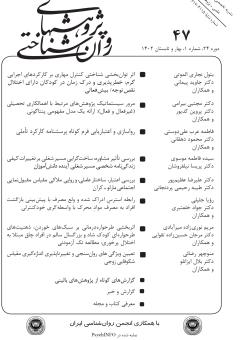اثر توانبخشی شناختی کنترل مهاری بر کارکردهای اجرایی گرم: خطرپذیری و درک زمان در کودکان دارای اختلال نقص توجه/ بیشفعالی
محورهای موضوعی : روان شناسیبتول نجاری الموتی 1 , جاوید پیمانی 2 * , مریم بهرامی هیدجی 3 , شیدا سوداگر 4 , ناهید هواسی سومار 5
1 - دانشگاه آزاد اسلامی، واحد کرج، گروه روانشناسی
2 - دانشگاه آزاد اسلامی، واحد کرج، گروه روانشناسی
3 - دانشگاه آزاد اسلامی، واحد کرج، گروه روانشناسی
4 - دانشگاه آزاد اسلامی، واحد کرج، گروه روانشناسی سلامت
5 - دانشگاه آزاد اسلامی، واحد کرج، گروه مشاوره
کلید واژه: توانبخشی شناختی, کنترل مهاری, خطرپذیری, درک زمان, اختلال نقص توجه/ بیشفعالی,
چکیده مقاله :
چکیده: پژوهش حاضر با هدف بررسی اثر توانبخشی شناختی کنترل مهاری بر دو کارکرد اجرایی گرم: خطرپذیری، و درک زمان، در کودکان مبتلا به اختلال نقص توجه/ بیشفعالی انجام شد. طرح پژوهش از نوع نیمهآزمایشی با طرح پیشآزمون، پسآزمون، و پیگیری با گروه کنترل بود. تعداد 30 دانشآموز دختر و پسر ۷ تا ۱2 سال مقطع ابتدایی که در سال تحصیلی 1401-1400 در شهر تهران مشغول به تحصیل بودند و تشخیص اختلال نقص توجه/ بیشفعالی را داشتند با استفاده از روش نمونهگیری هدفمند انتخاب و به روش تصادفی در دو گروه آزمایش و کنترل گمارده شدند. برای جمعآوری دادهها، از پرسشنامه اسنپ IV، تکلیف رایانهای سنجش خطرپذیری بارت (BART)، و تکلیف رایانهای بازتولید زمان استفاده شد و برای تجزیه و تحلیل دادهها روش تحلیل واریانس آمیخته با اندازهگیری مکرر به کار رفت. نتایج نشان دادند که در عملکرد گروه آزمایش و گروه کنترل در مؤلفة خطرپذیری و در تکلیف فواصل زمانی بلند مدت از مولفة درک زمان، تفاوت وجود دارد (05/0P<) اما در تکلیف فواصل زمانی کوتاه مدت، بین دو گروه تفاوت معنادار مشاهده نشد. در مجموع چنین بهدست آمد که تکالیف رایانهای ساختاریافته با هدف تقویت مهار تداخل و پاسخ، در دانشآموزان مبتلا به اختلال نقص توجه/ بیشفعالی، به بهبود دو کارکرد اجرایی گرم یعنی خطرپذیری و درک زمان (فواصل زمانی بلندمدت) کمک میکند.
Abstract: The present study was conducted with the aim of investigating the effect of inhibitory control cognitive rehabilitation on hot executive functions: risky decision making and time perception in children with attention deficit/hyperactivity disorder. The research design was semi-experimental with a pre-test, post-test and follow-up with a control group. The statistical population includes male and female students between 7 and 12 years old in elementary schools of Tehran in the academic year 2020-2021 who were suffering from attention deficit/ hyperactiv ity disorder. Among them, 30 students were selected by purposeful sampling method and randomly placed in the experimental and control groups. The SNAP-IV Questionnaire, the Computerized Task Risk Analogue Balloon (BART) and the Time Reproduction Computer Task were used to collect information. For data analysis, using SPSS24 software, variance analysis method with repeated measurements was used. The results showed that there is difference in the perfor-mance of the experimen tal group and the control group in the components of: risky decision making and time perception for long-term intervals (P<0.05). However, compared to the control group, no significant difference was shown between the time reproduction component for short-term intervals in the experimental group. According to the results structured games aimed at enhancing interference inhibition and responding can improve hot executive functions, risky decision making and time perception (long-term intervals) in students with attention-deficit/hyperactivity disorder.

